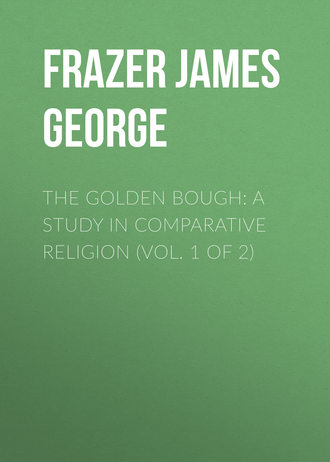
The Golden Bough: A Study in Comparative Religion (Vol. 1 of 2)
1146
W. Mannhardt, Mythol. Forsch. p. 333 sq.
1147
Ib. p. 334.
1148
Ib. p. 334.
1149
W. Mannhardt, op. cit. p. 336.
1150
Ib. p. 336.
1151
Ib. p. 336; Baumkultus, p. 612.
1152
W. Mannhardt, Die Korndämonen, p. 28.
1153
W. Mannhardt, l. c.
1154
Ib.; Henderson, Folk-lore of the Northern Counties, p. 87; Brand, Popular Antiquities, ii. 20, Bohn's ed.; Chambers's Book of Days, ii. 377 sq. Cp. Folk-lore Journal, vii. 50.
1155
Brand, op. cit. ii. 21 sq.
1156
Folk-lore Journal, vi. 268 sq.
1157
From information supplied by Archie Leitch, gardener, Rowmore, Garelochhead.
1158
Communicated by Mr. Macfarlane of Faslane, Gareloch.
1159
Jamieson, Dictionary of the Scottish Language, s. v. “Maiden.”
1160
W. Gregor, in Revue des Traditions populaires, iii. 533 (485 B); id., Folk-lore of the North-East of Scotland, p. 182. An old Scottish name for the Maiden (autumnalis nymphula) was Rapegyrne. See Fordun, Scotichron. ii. 418, quoted in Jamieson's Dict. of the Scottish Language, s. v. “Rapegyrne.”
1161
W. Mannhardt, Die Korndämonen, p. 30; Folk-lore Journal, vii. 50.
1162
W. Mannhardt, l. c.; Sommer, Sagen, Märchen und Gebräuche aus Sachsen und Thüringen, p. 160 sq.
1163
See above, p. 83 sqq.
1164
Above, pp. 333, 344.
1165
Above, p. 307.
1166
Above, p. 67 sqq.
1167
Above, pp. 334, 335.
1168
Above, pp. 334, 345.
1169
See above, p. 335 sq.
1170
Above, p. 340; cp. Kuhn, Westfälische Sagen, Gebräuche und Märchen, ii. No. 516.
1171
Above, pp. 336, 337, 345.
1172
See above, p. 9 sqq.
1173
Above, p. 341.
1174
Above, p. 338.
1175
Above, p. 334, cp. 335.
1176
Above, pp. 334, 345.
1177
Above, p. 344 sq.; W. Mannhardt, Korndämonen, pp. 7, 26. Amongst the Wends the last sheaf, made into a puppet and called the Old Man, is hung in the hall till next year's Old Man is brought in. Schulenburg, Wendisches Volksthum, p. 147. In Inverness and Sutherland the Maiden is kept till the next harvest. Folk-lore Journal, vii. 50, 53 sq. Cp. Kuhn, Westfälische Sagen, Gebräuche und Märchen, ii. Nos. 501, 517.
1178
Acosta, Hist. of the Indies, v. c. 28, vol. ii. p. 374 (Hakluyt Society, 1880).
1179
W. Mannhardt, Mythol. Forsch. p. 342 sq. Mannhardt's authority is a Spanish tract (Carta pastoral de exortacion e instruccion contra las idolatrias de los Indios del arçobispado de Lima) by Pedro de Villagomez, Archbishop of Lima, published at Lima in 1649, and communicated to Mannhardt by J. J. v. Tschudi.
1180
Brasseur de Bourbourg, Histoire des Nations civilisées du Mexique, iii. 40 sqq.
1181
H. M. Elliot, Supplemental Glossary of Terms used in the North Western Provinces, edited by J. Beames, i. 254.
1182
Spenser St. John, Life in the Forests of the Far East,2 i. 187, 192 sqq.
1183
E. B. Cross, “On the Karens,” in Journal of the American Oriental Society, iv. 309.
1184
See above, p. 346.
1185
Veth, Java, i. 524-526.
1186
Homer, Od. v. 125 sqq.; Hesiod, Theog. 969 sqq.
1187
See above, p. 343 sq.
1188
It is possible that a ceremony performed in a Cyprian worship of Ariadne may have been of this nature. Plutarch, Theseus, 20, ἐν δὴ τῇ θυσίᾳ τοῦ Γορπιαίου μηνὸς ἱσταμένου δευτέρα κατακλινόμενον τινα τῶν νεανίσκων φθέγγεσθαι καὶ ποιεῖν ἄπερ ὠδινοῦσαι γυναῖκες. We have already seen grounds for regarding Ariadne as a goddess or spirit of vegetation (above, p. 104). If, however, the reference is to the Syro-Macedonian calendar, in which Gorpiaeus corresponds to September (Daremberg et Saglio, i. 831), the ceremony could not have been a harvest celebration, but may have been a vintage one. Amongst the Minnitarees in North America, the Prince of Neuwied saw a tall strong woman pretend to bring up a stalk of maize out of her stomach; the object of the ceremony was to secure a good crop of maize in the following year. Maximilian, Prinz zu Wied, Reise in das innere Nord-Amerika, ii. 269.
1189
W. Mannhardt, Baumkultus, pp. 468 sq., 480 sqq.; id., Antike Wald- und Feldkulte, p. 288 sq.; id., Mythologische Forschungen, pp. 146 sqq., 340 sqq.; Van Hoëvell, Ambon en de Oeliasers, p. 62 sq.; Wilken, in Indische Gids, June 1884, pp. 958, 963 sq. Cp. Marco Polo, trans. Yule,2 i. 212 sq.
1190
See above, p. 335 sq.
1191
Cp. Preller, Griech. Mythol.3 i. 628, note 3. In Greece the annual descent of Proserpine appears to have taken place at the Great Eleusinian Mysteries and at the Thesmophoria, that is, about the time of the autumn sowing. But in Sicily her descent seems to have been celebrated when the corn was fully ripe (Diodorus, v. 4), that is, in summer.
1192
Homer, Hymn to Demeter, 401 sqq.; Preller, l. c.
1193
In some places it was customary to kneel down before the last sheaf, in others to kiss it. W. Mannhardt, Korndämonen, 26; id., Mytholog. Forschungen, p. 339; Folk-lore Journal, vi. 270.
1194
Above, p. 332 sq.
1195
In the Homeric Hymn to Demeter, she is represented as controlling the growth of the corn. See above, p. 331.
1196
See above, pp. 305 sqq., 309 sqq.
1197
Pauly, Real-Encyclopadie der class. Alterthumswiss. v. 1011.
1198
Above, p. 105 sq.
1199
Diodorus, i. 14, ἔτι γὰρ καὶ νῦν κατὰ τὸν θερισμόν τούς πρώτους ἀμηθέντας στάχυς θέντας τοὺς ἀνθρώπους κόπτεσθαι πλησίον τοῦ δράγματοσ κ.τ.λ. For θέντας we should perhaps read σύνθεντας, which is supported by the following δράγματος.
1200
Herodotus, ii. 79; Pollux, iv. 54; Pausanias, ix. 29; Athenaeus, 620 A.
1201
Brugsch, Adonisklage und Linoslied, p. 24.
1202
Above, p. 355.
1203
Ralston, Songs of the Russian People, p. 249 sq.
1204
Homer, Il. xviii. 570; Herodotus, ii. 79; Pausanias, ix. 29; Conon, Narrat. 19. For the form Ailinus see Suidas, s. v.; Euripides, Orestes, 1395; Sophocles, Ajax, 627. Cp. Moschus, Idyl. iii. 1; Callimachus, Hymn to Apollo, 20.
1205
Conon, l. c.
1206
W. Mannhardt, A. W. F. p. 281.
1207
Pausanias, l. c.
1208
Pollux, iv. 54; Athenaeus, 619 f, 620 a; Hesychius, svv. Βῶρμον and Μαριανδυνὸς θρῆνος.
1209
The story was told by Sositheus in his play of Daphnis. His verses have been preserved in the tract of an anonymous writer. See Scriptores rerum mirabilium, ed. Westermann, p. 220; also Athenaeus, 415 b; Schol. on Theocritus, x. 41; Photius, Suidas, and Hesychius, s. v. Lityerses; Apostolius, x. 74. Photius mentions the sickle. Lityerses is the subject of a special study by Mannhardt (Mythologische Forschungen, p. 1 sqq.), whom I follow.
1210
Pollux, iv. 54.
1211
In this comparison I closely follow Mannhardt, Myth. Forsch. p. 18 sqq.
1212
Cp. above, p. 340. On the other hand, the last sheaf is sometimes an object of desire and emulation. See p. 336. It is so at Balquhidder also, Folk-lore Journal, vi. 269; and it was formerly so on the Gareloch, Dumbartonshire, where there was a competition for the honour of cutting it, several handfuls of standing corn being concealed under sheaves. – (From the information of Archie Leitch. See note on p. 345).
1213
W. Mannhardt, Myth. Forsch. p. 19 sq.
1214
W. Mannhardt, Myth. Forsch. p. 20; Panzer, Beitrag zur deutschen Mythologie, ii. 217.
1215
Above, p. 346 sq.
1216
W. Mannhardt, Myth. Forsch. p. 22.
1217
W. Mannhardt, Myth. Forsch. p. 22.
1218
Ib. p. 22 sq.
1219
Ib. p. 23.
1220
Ib. p. 23 sq.
1221
Ib. p. 24.
1222
W. Mannhardt, Myth. Forsch. p. 24.
1223
Ib. p. 24.
1224
Ib. p. 24 sq.
1225
Ib. p. 25.
1226
Witzschel, Sagen, Sitten und Gebräuche aus Thüringen, p. 223.
1227
W. Mannhardt, op. cit. p. 25 sq.
1228
C. A. Elliot, Hoshangábád Settlement Report, p. 178, quoted in Panjab Notes and Queries, iii. Nos. 8, 168.
1229
W. Mannhardt, Myth. Forsch. p. 31.
1230
Ib. p. 334.
1231
W. Mannhardt, Myth. Forsch. p. 330.
1232
Ib.
1233
Ib. p. 331.
1234
Ib. p. 335.
1235
Ib. p. 335.
1236
Above, pp. 335, 341, 350.
1237
W. Mannhardt, Korndäm., p. 26.
1238
Above, p. 343.
1239
W. Mannhardt, M. F. p. 50.
1240
Ib. p. 50 sq.
1241
See above, pp. 286 sq., 333, 337, 340, 341.
1242
W. Mannhardt, op. cit. p. 32 sqq. Cp. Revue des Traditions populaires, iii. 598.
1243
W. Mannhardt, Mythol. Forsch. p. 35 sq.
1244
Ib. p. 36.
1245
For the evidence, see ib. p. 36, note 2. The idea which lies at the bottom of the phrase seems to be explained by the following Cingalese custom. “There is a curious custom of the threshing-floor called ‘Goigote’ – the tying of the cultivator's knot. When a sheaf of corn has been threshed out, before it is removed the grain is heaped up and the threshers, generally six in number, sit round it, and taking a few stalks, with the ears of corn attached, jointly tie a knot and bury it in the heap. It is left there until all the sheaves have been threshed and the corn winnowed and measured. The object of this ceremony is to prevent the devils from diminishing the quantity of corn in the heap.” C. J. R. Le Mesurier, “Customs and Superstitions connected with the Cultivation of Rice in the Southern Province of Ceylon,” in Journal of the Royal Asiatic Society, N.S., xvii. (1885) 371. The “key” in the European custom is probably intended to serve the same purpose as the “knot” in the Cingalese custom.
1246
W. Mannhardt, op. cit. p. 39.
1247
W. Mannhardt, Myth. Forsch. p. 39 sq.
1248
Ib. p. 40. For the speeches made by the woman who binds the stranger or the master, see ib. p. 41; Lemke, Volksthümliches in Ostpreussen, i. 23 sq.
1249
W. Mannhardt, Myth. Forsch. p. 41 sq.
1250
W. Mannhardt, op. cit. p. 42.
1251
Ib. p. 42. See above, p. 343. In Thüringen a being called the Rush-cutter used to be much dreaded. On the morning of St. John's Day he was wont to walk through the fields with sickles tied to his ankles cutting avenues in the corn as he walked. To detect him, seven bundles of brushwood were silently threshed with the flail on the threshing-floor, and the stranger who appeared at the door of the barn during the threshing was the Rush-cutter. Witzschel, Sagen, Sitten und Gebräuche aus Thüringen, p. 221. With the Binsenschneider compare the Bilschneider. Panzer, Beitrag zur deutschen Mythologie, ii. 210 sq.
1252
W. Mannhardt, op. cit. p. 47 sq.
1253
Ib. p. 48. To prevent a rationalistic explanation of this custom, which, like most rationalistic explanations of folk-custom, would be wrong, it may be pointed out that a little of the crop is sometimes left on the field for the spirit under other names than “the Poor Old Woman.” Thus in a village of the Tilsit district, the last sheaf was left standing on the field “for the Old Rye-woman.” M. F. p. 337. In Neftenbach (Canton of Zürich) the first three ears of corn reaped are thrown away on the field “to satisfy the Corn-mother and to make the next year's crop abundant.” Ib. In Thüringen when the after-grass (Grummet) is being got in, a little heap is left lying on the field; it belongs to “the Little Wood-woman” in return for the blessing she has bestowed. Witzschel, Sagen, Sitten und Gebräuche aus Thüringen, p. 224. At Kupferberg, Bavaria, some corn is left standing on the field when the rest has been cut. Of this corn left standing, they say that “it belongs to the Old Woman,” to whom it is dedicated in the following words —
“We give it to the Old Woman;She shall keep it.Next year may she be to usAs kind as this time she has been.”
M. F. p. 337 sq. These last expressions are quite conclusive. See also Mannhardt, Korndämonen, p. 7 sq. In Russia a patch of unreaped corn is left in the field and the ears are knotted together; this is called “the plaiting of the beard of Volos.” “The unreaped patch is looked upon as tabooed; and it is believed that if any one meddles with it he will shrivel up, and become twisted like the interwoven ears.” Ralston, Songs of the Russian People, p. 251. In the North-east of Scotland a few stalks were sometimes left unreaped for the benefit of “the aul' man.” W. Gregor, Folk-lore of the North-East of Scotland, p. 182. Here “the aul' man” is probably the equivalent of the Old Man (der Alte) of Germany.
1254
M. F. p. 48.
1255
Ib. p. 48 sq.
1256
Ib. p. 49.
1257
Ib. p. 49 sq.; Wuttke, Der deutsche Volksaberglaube,2 § 400; Töppen, Aberglaube aus Masuren,2 p. 57.
1258
The explanation of the custom is Mannhardt's. M. F. p. 49.
1259
Odyssey, xvii. 485 sqq. Cp. Plato, Sophist, 216 a.
1260
For throwing him into the water, see p. 374.
1261
Cieza de Leon, Travels, translated by Markham, p. 203 (Hakluyt Society, 1864).
1262
Brasseur de Bourbourg, Histoire des Nations civilisées du Mexique, i. 274; Bancroft, Native Races of the Pacific States, ii. 340.
1263
Bastian, Die Culturländer des alten Amerika, ii. 639 (quoting Herrara). See above, p. 307.
1264
E. James, Account of an Expedition from Pittsburgh to the Rocky Mountains, ii. 80 sq.; Schoolcraft, Indian Tribes, v. 77 sqq.; De Smet, Voyages aux Montagnes Rocheuses, nouvelle ed. 1873, p. 121 sqq. The accounts by Schoolcraft and De Smet of the sacrifice of the Sioux girl are independent and supplement each other.
1265
Labat, Relation historique de l'Ethiopie occidentale, i. 380.
1266
John Adams, Sketches taken during Ten Voyages in Africa between the years 1786 and 1800, p. 25.
1267
P. Bouche, La Côte des Esclaves, p. 132.
1268
Arbousset et Daumas, Voyage d'exploration au Nord-est de la Colonie du Cap de Bonne-Esperance, p. 117 sq.
1269
Panjab Notes and Queries, ii. No. 721.
1270
Major S. C. Macpherson, Memorials of Service in India, p. 113 sq.; Major-General John Campbell, Wild Tribes of Khondistan, pp. 52-58, etc.
1271
J. Campbell, op. cit. p. 56.
1272
S. C. Macpherson, op. cit. p. 115 sq.
1273
Ib. p. 113.
1274
S. C. Macpherson, op. cit. p. 117 sq.; J. Campbell, p. 112.
1275
S. C. Macpherson, p. 118.
1276
J. Campbell, p. 54.
1277
Ib. pp. 55, 112.
1278
S. C. Macpherson, p. 119; J. Campbell, p. 113.
1279
S. C. Macpherson, p. 127. Instead of the branch of a green tree, Campbell mentions two strong planks or bamboos (p. 57) or a slit bamboo (p. 182).
1280
J. Campbell, pp. 56, 58, 120.
1281
Dalton, Ethnology of Bengal, p. 288, quoting Colonel Campbell's Report.
1282
J. Campbell, p. 126. The elephant represented the Earth Goddess herself, who was here conceived in elephant-form; Campbell, pp. 51, 126. In the hill tracts of Goomsur she was represented in peacock-form, and the post to which the victim was bound bore the effigy of a peacock, Campbell, p. 54.
1283
S. C. Macpherson, p. 130.
1284
Dalton, Ethnology of Bengal, p. 288, referring to Colonel Campbell's Report.
1285
S. C. Macpherson, p. 129. Cp. J. Campbell, pp. 55, 58, 113, 121, 187.
1286
J. Campbell, p. 182.
1287
S. C. Macpherson, p. 128; Dalton, l. c.
1288
J. Campbell, pp. 55, 182.
1289
J. Campbell, p. 187.
1290
J. Campbell, p. 112.
1291
S. C. Macpherson, p. 118.
1292
Above, pp. 383, 384.
1293
Above, pp. 334, 335.
1294
Above, pp. 333, 344, 345.
1295
Above, p. 372.
1296
Above, p. 374.
1297
Above, pp. 286 sq., 337, 340, 374.
1298
Above, p. 374.
1299
W. Mannhardt, Korndämonen, p. 5.
1300
Pfannenschmid, Germanische Erntefeste, p. 98.
1301
Above, p. 376 sq.
1302
Above, p. 235.
1303
Above, p. 299.
1304
Above, p. 68.
1305
I do not know when the corn is reaped in Phrygia; but considering the high upland character of the country, harvest is probably later there than on the coasts of the Mediterranean.
1306
Above, p. 364 sq.
1307
Above, p. 365.
1308
Hesychius, s. v. Βῶρμον.
1309
Apollodorus, ii. 6, 3.
1310
The scurrilities exchanged in both ancient and modern times between vine-dressers, vintagers, and passers-by seem to belong to a different category. See W. Mannhardt, Myth. Forsch. p. 53 sq.
1311
Above, p. 282 sqq.
1312
Above, p. 283 sq.
1313
Above, pp. 381, 384, 389.
1314
For this fact of the probable correspondence of the months, which supplies so welcome a confirmation of the conjecture in the text, I am indebted to my friend Professor W. Robertson Smith, who furnishes me with the following note: “In the Syro-Macedonian calendar Lous represents Ab, not Tammuz. Was it different in Babylon? I think it was, and one month different, at least in the early times of the Greek monarchy in Asia. For we know from a Babylonian observation in the Almagest (Ideler, I. 396) that in 229 b. c. Xanthicus began on February 26. It was therefore the month before the equinoctial moon, not Nisan but Adar, and consequently Lous answered to the lunar month Tammuz.”
1315
Above, p. 364.
1316
Apollodorus, ii. 5, 11; Schol. on Apollonius Rhodius, iv. 1396; Plutarch, Parall. 38. Herodotus (ii. 45) discredits the idea that the Egyptians ever offered human sacrifices. But his authority is not to be weighed against that of Manetho (Plutarch, Is. et Os. 73), who affirms that they did.
1317
E. Meyer, Geschichte des Alterthums, i. § 57.
1318
Diodorus, i. 88; Plutarch, Is. et Os. 73; cp. id., 30, 33.
1319
Above, pp. 307, 383, 391.
1320
Festus, s. v. Catularia. Cp. id., s. v. rutilae canes; Columella, x. 343; Ovid, Fasti, iv. 905 sqq.; Pliny, N. H. xviii. § 14.
1321
Panzer, Beitrag zur deutschen Mythologie, ii. 207, No. 362; Bavaria, Landes- und Volkskunde des Königreichs Bayern, iii. 343.
1322
Above, pp. 384, 389.
1323
Above, pp. 381, 383.
1324
Plutarch, Is. et Os. 18.
1325
Plutarch, Is. et Os. 22, 30, 31, 33, 73.
1326
Wilkinson, Manners and Customs of the Ancient Egyptians (ed. 1878), iii. 81.
1327
Pausanias, i. 22, 3, viii. 5, 8, viii. 42, 1








